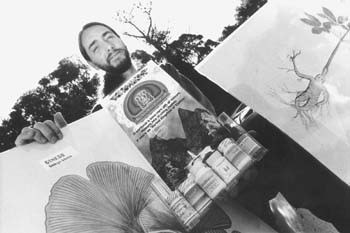Trip the Right Fantastic
'Shroom Me While I Kiss the Sky: Fungalore mastermind Gus Turpin has a wide array of herbal spirit tonics to give healthy types a natural boost.
A healthy high just may be found in a SC company's user-friendly fungus formula
By Mary Spicuzza
THE TECHNO-HOUSE MUSIC has been throbbing for hours, the moon is setting in the big pink sky, and most of the ravers are packing up their party whistles and fairy wings and heading home. But as the crowd shrivels, there's one lone dancer still fervently trip-hopping in his own universe. Most would assume it's ecstasy, acid or some other illegal synthetic substance propelling such a high. Yet with this decade's explosion of herbal alternatives, the happy raver is just as likely to be high on Fungalore.
Santa Cruz resident Edward Augustus "Fun Gus" Turpin, who created the "occasional herbal supplement" known as Fungalore, explains it was created to induce a high that is "less likely to cause burn-out, depression and depletion associated with many legal and illegal recreational substances."
Turpin's Shamanic Tonics, a locally owned and operated company, has been in the business of providing "adaptogenic" herbal formulas nationwide for over four years. Adaptogenic means the herbs can be used for a wide variety of purposes, but tend to "have a normalizing or regulating effect in general," as Turpin puts it.
Turpin speaks with a soothing voice and a lurking smile. Although he towers at least a foot over most of the population, Turpin comes off about as threatening as a gazelle. He says he became interested in herbs in high school and started seriously blending formulas about 12 years ago. At age 34, Turpin has studied at an extensive list of schools of alternative medicine. After earning a bachelor's degree in philosophy at Sonoma State University, he attended the Oregon College of Oriental Medicine and the National College of Naturopathic Medicine and got a master's degree at Five Branches School of Chinese Medicine.
Shamanic Tonics' formulas are more than a random jumble of herbs. Turpin breaks down the process of creating a product into four stages. "I have the basis of years of research, and from there follow my own hunches of what combinations would work well together," he says. "I then do extensive self-experimentation before giving the herbs to others to sample. Only after that do I package them as finished products."
While pharmaceutical companies typically rely on bunnies, rats and willing humans to test their products, brave-hearted Turpin has always served as his own guinea pig. Apparently no serious catastrophes have occurred in sampling, though his first strong cup of ma hwang tea left the unsuspecting mixmaster awake for two nights.
Turpin began Shamanic Tonics in 1994 with the goal of creating a life-affirming business. "We view business as a potential bridge toward a more full life for the individual, society and the world as a whole," Turpin explains in glistening language that would leave the smoothest-talking CEO feeling like a mute at a sideshow barkers' convention. His company has a vision for a Planet Plant Plan, "developing an economy and society that not only sustains but enhances our natural resources." Turpin hopes to ride the '90s wave that hitches ancient wisdom to innovative, modern methods.
Herbal Highs
FUNGALORE IS PROBABLY Shamanic Tonics' most talked-about product. "X-perience a once rare gift of nature, Venture into X-citing realms, X-plore an 'Herbal Kingdom of Elation', " boasts an illustrated Fungalore promo poster right out of a Coleridge opium-conjured hallucination.
The main ingredients of the elixir include "Mushroom of Immortality Fungus," ma hwang, "guru nut," white ginseng root, green tea and about 10 other herbs. Fans of the fungal blend say it has brought them an intense--albeit temporary--sense of clarity and happiness, as well as an energizing high much like ecstasy but without the synthetic feeling.
Other Shamanic specialties include Siber-Cord Gold, made mostly of Siberian ginseng and cordyceps fungus and based on concoctions used by many of China's Gold-medal winning Olympic athletes (a similar blend is a fave of Russian cosmonauts). The company also created Yohimbe Power, a blend named after the African "love bark," an herb used to cure impotence and increase athletic performance, and came up with "Meditation" for folks who want an herbal comedown.
One might think "herbal" and "high" would be banned from use in the same sentence after the widely publicized 17 deaths and hundreds of hospitalizations tied to recreational herbal supplements, especially those containing combinations of ephedrine (naturally occurring in ma hwang) and caffeine. However, Turpin stands by the safety of his products, of which only Fungalore contains ma hwang.
"Ma hwang can both lower and raise blood pressure," Turpin says, "whereas isolated ephedrine is more likely to cause palpitations. But I believe--because of economic reasons--ma hwang was targeted for banning or regulation while ephedrine has been left on the shelves. Like any high, though, it must be obtained responsibly and according to the recommended dosage."
Turpin feels that most complications occurred in cases where people refused to follow the recommended dosages or individuals with a history of heart problems didn't heed warning labels. A virtual encyclopedia of mushroom medicines, he is quick to point out that the combination of ephedrine and caffeine was highly recommended in 1995 by no other than an AMA-approved Townsend Letter for Doctors and Patients, shortly before the string of negative press.
While thousands of deaths have been linked to alcohol and tobacco, they remain completely legal, and most pharmaceuticals are toxic if recommended dosages and uses are not followed. Despite waves of negative press and FDA mistrust after the ma hwang scare, herbal products from companies such as Shamanic Tonics continue in their quest to redefine the natural high.
Copyright © Metro Publishing Inc. Maintained by Boulevards New Media.

Robert Scheer
From the Dec. 4-10, 1997 issue of Metro Santa Cruz.
![[MetroActive Dining]](/dining/gifs/dining468.gif)